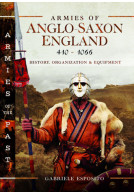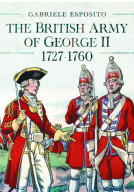Armies of the Vikings, AD 793–1066 (Hardback)
History, Organization and Equipment
Imprint: Pen & Sword Military
Pages: 176
Illustrations: 50 colour illustrations
ISBN: 9781399008396
Published: 13th October 2021
(click here for international delivery rates)
Need a currency converter? Check XE.com for live rates
| Other formats available - Buy the Hardback and get the eBook for £1.99! | Price |
|---|---|
| Armies of the Vikings, AD 793–1066 eBook (47.6 MB) Add to Basket | £6.99 |
Viking warriors were feared by their contemporaries and their ferocious reputation has survived down to the present day. This book covers the military history of the Vikings from their early raiding to the final failure of their expansionist ambitions directed against England. In that period Viking warbands and increasingly large armies had left their Scandinavian homelands to range across vast regions, including the whole of Northern Europe and beyond, even reaching North America. The British Isles were terrorized for two centuries and at times largely conquered, in Normandy, Russia and elsewhere they also settled and founded states. Tough, skilled and resourceful, with a culture that embraced the pursuit of immortal fame and a heroic death in battle, their renown as warriors was second to none. As far afield as Constantinople, the Byzantine emperors employed them as their elite Varangian Guard.
Gabriele Esposito outlines the history of their campaigns and battles and examines in detail their strategy, tactics, weapons, armour and clothing. The subject is brought to life by dozens of colour photographs of replica equipment in use.
This book is an extremely enlightening and detailed history of the Vikings. Of Scandinavian origin they belonged to a group of Norsemen from Denmark, Southern Norway, and Sweden. In Western Europe they are known as Vikings and in Eastern Europe as Varangians. They inhabited an inhospitable cold northern climate living in small tribal and pagan rural farming communities. Although their commercial activities were limited, they were competent metal workers and traded with amber during the Roman period. By the mid-8th century, the climate had begun to warm, improving agricultural output, which was accompanied by an expansion in population increasing the pressure upon the available living space. Discontent grew for many who looked for new opportunities elsewhere and to utilise their shipbuilding and navigation skills of sea ways and rivers to explore new lands of opportunity.
Roger Coleman
The first tentative raid on the British Isles by the Vikings occurred in 793 when they landed at Portland on the coast of Dorset. Encountering local inhabitants, misunderstandings occurred resulting in their deaths and the withdrawal of the Vikings. Four years later a more significant raid took place at Lindisfarne, a Christian religious site, which was desecrated and looted by the Vikings who killed monks and others. The destruction caused widespread concern across Northumbria with the realisation that Anglo-Saxon England was vulnerable to future raids.
Lessons learnt by the Vikings in their early raids were maximised in a full-scale invasion of Wessex in 840. The Anglo-Saxons fought and lost the Battle of Carhampton, Somerset, led by Athelwulf, King of Wessex. Over the following twenty years the Vikings continued to raid and plunder Wessex more-or-less at will despite sporadic Saxon victories. A large force of Vikings composed of Danes, Swedes, and Norwegians – The Great Heathen Army – landed in Kent in 865. England at that period was divided into seven small kingdoms, with no centralised governance until the rise of Alfred the Great, who became the first King of the Anglo-Saxons. After a series of battles a compromise was reached with the Vikings and a peace treaty agreed with Alfred in 878. Alfred had control of southern and eastern England while the Vikings held northern and western parts under Danelaw. Danegeld, a tax, was raised for payment to the Viking raiders to prevent the land from being further ravaged. After Alfred’s death in 899 squabbles for the Saxon throne descended into chaos and civil war. Mainland Scotland, the Scottish Isles, Wales, and Ireland were all subjected to Vikings incursions with varying degrees of success, which is comprehensively explained by the author.
The Scandinavians did not confine themselves to raids on the British Isles, they invaded other European coastlines bordering the North Sea. Brittany, in France was used to launch raids on England. Normandy was ceded to the Vikings after a series of confrontations by the King of France. Normandy derives its name from the ‘Land of Noresemen’.
It was not until 1017 that the Vikings achieved their goal of conquering England. The Danish King Cnut became King of England heralding a period of peace and stability for the Anglo-Saxon population and the assimilation of Vikings into the community. Cnut also ruled over substantial parts of Northern Europe. The next major turning point and the end of the Anglo-Saxon period occurred in 1066 when William, Duke of Normandy invaded England and defeated Harold Godwinson at the Battle of Hastings. He was proclaimed King William I of England, which had significant impact on the future history of England.
While Danish and Norwegian Vikings focused on the west, the Swedish Vikings moved eastwards establishing a commercial empire and colonising vast areas of Eastern Europe from the Baltic to the Black Sea. The Varangians are considered to the be the founders of Russia. This aspect of Viking ambition and enterprise maybe not so well known as their western conquests but is historically, equally important.
The Norwegian Vikings had an innate sense to explore to the farthest western horizon of the known world which they believed extended across the Atlantic Ocean. Their well-designed ships powered by oarsman and sails, navigating by the sun and stars enabled them to sail westwards and to reach the north coast of North America. This was methodically achieved by sailing from Norway reaching firstly the Faroe Islands, then later onward to Iceland, Greenland, and Canada. Although they established settlements, Canada and Greenland were too far from their homeland to be supported. Nonetheless, these exploits across a vast ocean, without means of communication and any hope of rescue are a tribute to their seamanship and courage as they ventured into the unknown.
With England under Norman control and the influence of Christianity on the Scandinavians it signalled the end of the Viking age. Much of 10th and early 11th century Scandinavia was unstable. Norway, sought to dominant Sweden and Denmark marked by warfare. Gradually the realisation of the futility of war brought about the creation stable monarchies.
A full descriptive account of the Viking society, social interactions and military organisation is provided in the narrative. The elite warriors, the ‘Berserkers’ is of notable interest. Detailed descriptions of Viking military hardware, battle tactics, control, and co-ordination of movement on the battlefield and the relationship each warrior had with his weapons of war as symbols of his character are explained by the author. Vikings warriors wore protective equipment, the more prosperous helmets, chain mail and armour, others thick padded material.
Gabriele Esposito has produced a first-class book on a fascinating period of European history. For anyone who wants to gain an insight about the Vikings and their culture, then this book would be an ideal starting point for them. The research of primary and secondary archival material builds up a comprehensive history of these pioneering warriors of war and peace who travelled westwards and eastwards, far from their homeland and whose influence on European countries has percolated down through history to the present day. The narrative is accompanied by superb colour photographs of Viking re-enactors, bearing arms and equipment of western and eastern Vikings. Separate photographs are included of the weapons, shields, protective equipment, and clothing. There is also an index and a list of contact details of the groups of the re-enactors who contributed to the book.
An enjoyable exploration of the Vikings, packed with easy-to-digest information for both the Viking enthusiast and those who are marginally interested in learning more about them.
NetGalley, David Wiley
Rating: 5 out of 5 stars
NetGalley, Donde acaba el infinito
Addictive essay about war times in Viking Age. Well written, easy to follow, and full of interesting information.
Rating: 5 out of 5 stars
NetGalley, Annette Lamb
Exploring the military history (AD 793-1066) of the Vikings, this accessible work of nonfiction examines their global impact including key campaigns, battles, and warriors. Of particular note is the use of high quality color photographs of re-enactors and emphasis on strategy, tactics, weapons, armor, and clothing.
Rating: 5 out of 5 stars
NetGalley, Brandi Rawlins
A supposed descendant of mighty Vikings, particularly Erik the Great, I am always curious and interested in historical research related to Vikings. Armies of the Vikings, AD 793–1066, did not disappoint! The content is informative and brings these warriors to life. The explanations of their plights, reasons, and rationales for some choices were helpful. I love that it covers a lot of land and it written in a way that non-academics can enjoy. Saying that, the images were vivid and stunning and can hold the attention of any reader. I appreciated the re-enactors bringing these warriors to a contemporary audience.
Rating: 5 out of 5 stars
NetGalley, Dawn Lewis
Any book about Vikings is pretty much guaranteed to get at least 4 stars from me. "Armies of the Vikings, AD 793–1066" managed to get the top rating by bringing Viking armies to life. I almost expected to see a couple of Vikings charging through my living room! It's written in a style that makes it easy to read, it's entertaining, and the photos are an added bonus. Great stuff!
Rating: 5 out of 5 stars
NetGalley, Crystal Waldele
If you are looking for a definitive guide of the Vikings from 793-1066 AD, please check this book out. I’ve learned so much from this book, more than I ever thought possible. You do learn about the spread of the Vikings, how certain groups went to Britain, Ireland, Normandy, Brittany, Germany, Jutland, and even coming so far as to the shores of North America, long before any other sea-faring explorers.
One of my favorite quotes from this book was, “Consequently, we can say that all Vikings were Norsemen, but that only some Norsemen were Vikings.” That really hits when we hear all those people who have their ancestry traced back to Denmark, Norway, and Sweden, and automatically assume that their family were part of the ancient Vikings. We learn that not all Vikings went raiding and left their homeland. Some stayed and were farmers, they had villages, etc. It was only a portion that left.
You also learn what happened to different groups that left their homeland. We learned about their mindset for example, when a group realized that in order to get a foothold in what’s now called England, they would have to band together and fight the different kingdoms, they couldn’t do it on their own, that separate, they were too small.
We learned not only what was happening abroad, we learned what happened in their homeland as well. We learn about such battles as the Battle of Nesjar in 1016; the reign of Cnut the Great, ruler of not only England, but Denmark, Norway, and Sweden before finally passing in 1035.
No, we can’t talk about a Viking book that doesn’t talk about what the Vikings did later on when they hit the Kingdom of the Isles, Britain, Ireland, and all the minor islands. But the Vikings of course didn’t refer to them in those terms because no one did at that time. The Vikings referred to them as the “Northern Islands” and the “Southern Irelands”. The Northern Islands were the Shetlands and the Orkney Islands (mainly Norwegian). And the Southern Islands were the Hebrides, Islands of Firth and Clyde, and The Isle of Man (mainly Scandinavian). If you want to know what went on with all these islands, please check out this book. Like I stated previously, no school history book taught me so much.
The history of the area has been mostly a wild and hostile one at that time. There were always wars, battles, fighting. The Vikings were great raiders, and this was the first time I heard them referred to as pirates, but it makes sense.
I could go on and on, but if you want to really want to take a deep dive into the Vikings from 793AD until the beginning of the Middle Ages, please check this book out, Mr. Esposito has done a great job.
Armies of the Vikings is a truly fascinating fact-finding tour through the ages beautifully written by Gabriele Esposito.
NetGalley, John Derek
Well researched and well written, easy and clear to understand text. The book is full of wonderfully detailed observations of Viking life.
The book offers insight into Viking strategies and tactics and why they were so formidable.
As it covers the military history of the Vikings that played such a significant part in Great Britain’s history, it is an engaging read.
The subject is vividly brought to life by a variety of colour photographs of replica equipment in use.
The author has packed a lot into this publication, and thanks to the re-enactment societies, has bought the outfits and weaponry to life.
Perhaps the most misunderstood race of people in history, the Vikings continue to fascinate us nearly a thousand years since they first terrorised England and Europe.
NetGalley, Wyn Lewis
The first documented Viking raid on the British Isles occurred in 793 when a force ravaged the island of Lindisfarne. Their reign of terror ended in the turning-point year of 1066, when the Vikings saw their power diminished after defeat at the Battle of Stamford Bridge.
Gabrielle Esposito’s excellent book takes us from the early invasions and occupation of Mercia, East Anglia and Northumbria, through several battles between the Vikings and Saxons ending in a peace treaty and the creation of the Danelaw state in eastern England.
Several Scandinavian warlords enjoyed stints as Kings of England, culminating in the long reign of Cnut the Great from 1017. Eventually, Norman influence began to be felt in England with the reign of Edward the Confessor, culminating in the subsequent conquest of England by William the Conqueror at the Battle of Hastings in 1066. This decisive event marked the end of the Vikings’ plans to fully conquer England.
There are also chapters on the Viking presence in Wales, Scotland and Ireland, a section on the “Kingdom of the Isles”, (the name given to the islands surrounding the British Isles which were under Viking rule, such as the Shetlands and Orkney), and an overview of the Vikings in Europe. Their prowess as Medieval explorers is also explored.
A short, easy but informative read, Gabrielle Esposito has written an accessible guide to the Vikings which eschews the more fanciful myths in favour of hard facts. The book also includes many colour photos from the members of reenactment societies depicting the appearance of Viking warriors from various regions.
About Gabriele Esposito
Gabriele Esposito is an Italian researcher and a long-time student of military history, whose interests and expertise range widely over various periods. Most of his recent studies have been dedicated to the reconstruction of the organization, functioning and tactics of the armies across history; in each of his publications there is always some relevant space dedicated to the 'material culture'of the various armies taken into account and - more in particular - to the empirical science known as 'uniformology'. Gabriele is the author of numerous books on armies and uniforms and is a regular contributor to many specialized magazines in Italy, France, Netherlands and UK. His many previous works include Armies of Early Colonial North America 1607-1713; Armies of the Late Roman Empire 284-476; Armies of the Hellenistic States 323 BC to AD30; Armies of Celtic Europe 700 BC-AD 106; Armies of Ancient Greece, circa 500 BC to 338 BC; and The Macedonian Army of Philip II and Alexander the Great 359-323 BC, all published by Pen & Sword since 2018. He lives in southern Italy, near the ancient battlefield of Beneventum.





















